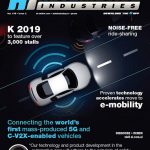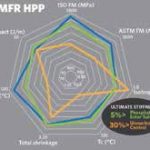Future mobility is getting closer day-by day, and is being actively shaped by leading industry engineers and designers from around the world.
Among them is Saint-Gobain Sekurit, long-time reference supplier for innovative glazing solutions for most car-makers. For Saint-Gobain Sekurit, the car is a new living place, with the same needs and prerequisites as a home.
This means new user experiences, a need for comfortable full interaction with not only the car but also its environment, bringing higher level of requirements. A good example of such innovation is AmpliSky, the company’s new switchable roof. It provides superior comfort and enables privacy on demand, creating an ambience of modernity and elegance.
Based on crystal liquid technology, Amplisky brings multiple benefits for all the passengers. Instant opaque to transparent switching An electronic switching roof gives passengers control over the natural light level they wish to enjoy during their journey. At the press of a button or control pad, the roof glass goes from transparent to opaque, or back again.
This brightens the interior on gloomy days, and protects occupants from glare, UV rays and heat on overly sunny days. There is the choice of switching completely, or stepping through segmented zones. Controls can be located on the instrument panel of the car or the directly on the roof glass.
OEMs can choose between sliding and touch controls. Thermal, acoustic, visual and comfort are all in AmpliSky AmpliSky is not only elegant; it also provides excellent acoustic comfort thanks to laminated glass construction. This reduces the heat in the cabin in the summer, but keeps the heat inside during winter to avoid the well-known “cold wall effect”. The effect is achieved using a high-quality coating developed by Saint-Gobain to provide superior comfort and anti-reflect properties.
No shutter needed Thanks to the thermal qualities of the glass, there is no need for a shutter or curtain below the transparent roof. This provides a weight saving of between 6-8kg by removing the different components and supplementary engine. No shutter also means less noise (rattling of shutter).
And with better thermal performance and a lighter car, there is a positive impact on the carbon footprint, says the company. Feeling of openness A complementary effect of having no shutter is the broadening of the possibilities in terms of car design. Having fewer components above the heads of the occupants creates a greater feeling of space – which is particularly important for children in the car.
There is also more physical space for passengers in the back seats. All passengers will enjoy AmpliSky for the total openness feeling, a sense of no limit between them and the sky.
The evolution of automotive glass
Automotive glass has evolved from being a barrier between the elements and the occupants to an integral part of the design, functions and features of modern automobiles. According to Saint-Gobain Sekurit, the timeline starts 95 years ago.
1927
The introduction of safety laminated and tempered glass, which is around five to 10 times stronger than regular glazing and shatters into small pebble-like fragments when broken.
1955
With the introduction of a high quality bending process, it became possible to produce backlites in complex shapes, instead of relatively flat ones.
1985
Heating elements are embedded in the laminated glazing for the rapid clearance of snow, ice and mist.
1986
Saint-Gobain Sekurit develops direct extrusion technology for the direct extrusion of plastic profiles on the glass periphery, creating a ready-to-install module.
1989
Encapsulation technology brings cosmetic improvements (design, integration and trims) and functionality (reinforcements, pins, clips) to automotive glazing.
1992
Dark tinted glazing improves passenger comfort and fuel efficiency.
1994
An invisible heat reflective coating acts as an infrared sun ray mirror, reducing the power and hence fuel consumption needed for air conditioning.
1996
The introduction of heatable glazing with a metallic coating makes it possible to supply laminated windscreens that can be de-iced or de-misted at the press of a button.
1998
The thickness of tempered automotive glazing is thinned down, saving around 2.5 kg per square metre of glass.
2001
Saint-Gobain Sekurit develops acoustic glazing, decreasing exterior noise by between three and five decibels.
2002
Polycarbonate glazing components are produced by Freeglass, a subsidiary of Saint-Gobain Sekurit.
2003
A large lamella sunroof from Saint-Gobain Sekurit brings a sense of openness and freedom for occupants.
2004
4 mm laminated sidelites reduces weight by 2.5 kg per square metre, and improves occupant safety and comfort.
2005
An electrochromic roof enables drives to control light intensity electronically.
2006
Saint-Gobain Sekurit develops processes to ensure a sharp image for head up displays (HUD).
2008
With the help of a new bending process, Saint-Gobain Sekurit produces acoustic windshields compatible with vehicles equipped with HUD.
2009
With a height of 1.5 m, the panoramic windshield is the biggest 2-in-1 windshield to be produced in this segment.
2010
The backlight of the Peugeot RCZ sets a new benchmark for double-bent complex lights.
2011
ClimaCoat windshield provides sun protection in summer and heating in winter.
2012
A heatable windshield for pure electric cars is introduced.
2013
Windshields trim down to 4mm thick, saving 1 kg per square metre of glass.
2014
Saint-Gobain Sekurit introduces a low-emissivity roof that keeps the cabin cooler in summer and warmer in winter: ComfortSky
2018
AmpliSky is introduced into the market. Passengers control light levels at the touch of a button. AmpliSky opens up new design possibilities while reducing heat gain in summer and loss in winter.














































 Mercedes-Benz to introduce an “uncrashable” car
Mercedes-Benz to introduce an “uncrashable” car Connecting C-V2X vehicles to cloud services
Connecting C-V2X vehicles to cloud services The Milliken product portfolio
The Milliken product portfolio Addressing the sensor challenges of next-generation autonomous vehicles
Addressing the sensor challenges of next-generation autonomous vehicles Cars Aren't Dead: They're just morphing into what comes next
Cars Aren't Dead: They're just morphing into what comes next Sweating the assets to leverage capital
Sweating the assets to leverage capital


